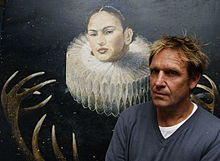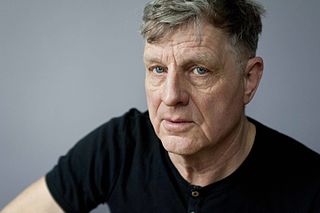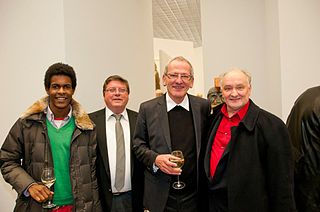Eric Peters | |
|---|---|
 | |
| Born | 3 October 1952 Stolberg, West Germany |
| Nationality | German |
| Known for | Painting |
Eric Peters (born 3 October 1952 in Stolberg (Rhineland), Germany) is a German painter, who now lives and works in Aachen.
Eric Peters | |
|---|---|
 | |
| Born | 3 October 1952 Stolberg, West Germany |
| Nationality | German |
| Known for | Painting |
Eric Peters (born 3 October 1952 in Stolberg (Rhineland), Germany) is a German painter, who now lives and works in Aachen.
After Eric Peters had finished his high school education he joined the Fachhochschule Aachen – the University of Applied Science in Aachen where he graduated from his fashion design studies with distinction in 1974. Peters is one of the famous graduates of this university. After joining an "Exhibition of Young Artists" at the Suermondt-Ludwig-Museum of Aachen, he was rewarded in 1976 with the Sponsorship Award of the City of Aachen. In 1976 Eric Peters joined the II. Symposium of the German-French-Youth-Exchange Organisation in the French town Bordeaux and realised the Kultur-Natur-Pyramide (Land Art in the Pyrenees). In 1979 Peters was sponsored by the German-French-Youth-Exchange Organisation, which allowed him to deepen his studies of art and design in France. Since 1979 Peters also designed and crafted furniture. In 1982 Peters founded the Design-Pool company. Peters' interest in east-Asian philosophies and life led him in 1986 to an intensive engagement with the Yoga-school of Vanda Scaravelli. His personal teacher at that time was Sandra Sabatini. Since 1987, Peters worked as a freelance artist. Peters has been successful in Europe and the U.S. and has had an exhibition in St. Petersburg, Russia.
Painting of Eric Peters in a German private house | |
|---|---|
 |
Eric Peters work circles the secrets of the creation and the depths of the human soul, which he aims to explore with the motif repertoire of portrait, landscape and animals. Anchored in the traditions of Symbolism, Dada, Surrealism and the Viennese School in Fantasia realism, he uses several traditions of the history of art. Eric Peters "charms the viewer with the high quality of execution and with the polisemy of the fantastic world of the unusual images. Playing with the human mentality, with our emotions and customary ideas about surrounding life is in the basis of Peters's art." [1] "The circle as a symbol of perfect harmony is found as a compositional basic element of Eric Peters painting in many of his works." [2] The circle refers to the struggle of the artist with the philosophical systems of East Asia. "Eric Peters's images draw the viewer with a fascinating force in a strange spell. The bizarre aesthetics of flawless strange women, animals and mythical creatures touch the human longing for mystery and beauty." [3] The illusion in the area and the sensuality of the paintings arouse the viewer's desire to explore the surface of the images not only with the eyes, but to touch the images, the flawless complexion of the woman faces, the skins of wild cats and the glass and to touch metal surfaces of bowls and jars. Eric Peters is a painter "of consciousness, a visualizer of psychic and psychotic states," writes Alexander Borovsky, head of the department for contemporary art movements of the Russian State Museum (Государственный Русский музей) Saint Petersburg in the catalog of the exhibition Light Games, and explains at the end of his remarks: "Eric Peters found a way that will be needed, since many feel a lack in modern art, a deficit of visual challenge to neo-Baroque, sculptural exuberance, of acrobatic circus tricks, and finally a lack of mystery. Peters' (art) is a kind of antidote for Hermeticism and the rationality of modern art. I think it works." [4] On 30 August 2010 Eckhard Hoog in the Aachener Nachrichten Online reported that Eric Peters "makes splash in Saint Petersburg" and plans a further exhibition in Houston, Texas, next year. [5]
Eric Peters describes the process and results of his work as a "Q-bistic superposition". [6] "The QBism (or derived Bayesian concept of probability) is an interpretation of the quantum theory that denies the objectivity of the quantum state and conceives it as an expression of a subjective belief of the observer" (because :)"a measurement reveales no pre-existing state of things' says Christopher Fuchs of the perimeter Institute in Waterloo Canada, one of the founders of the QBism,"(but:) "it is something that does an actor with the world and leading to the creation of a result, a new experience for this actor." [7] What Eric Peters happens in the creative painting process with his work, is figuratively that what the quantum mechanical examiner does with himself and the world.
The exhibition "Young Artists of Aachen" (Junge Kuenstler in Aachen) at the Suermondt-Ludwig-Museum in Aachen 1973 marks the beginning of Peters' public perception, then followed:

Rainer Fetting is a German painter and sculptor.
Horst Gläsker is a German artist. His work is a symbiosis of music, dance, theatre, drawing, painting, sculpture, installation and architecture.

Karl Otto Götz often simply called K.O. Götz, was a German artist, filmmaker, draughtsman, printmaker, writer and professor of art at the Kunstakademie Düsseldorf. He was one of the oldest living and active artists older than 100 years of age and is best remembered for his explosive and complex abstract forms. His powerful, surrealist-inspired works earned him international recognition in exhibitions like documenta II in 1959. Götz never confined himself to one specific style or artistic field. He also explored generated abstract forms through television art. Götz is one of the most important members of the German Art Informel movement. His works and teachings influenced future artists such as Sigmar Polke, Nam June Paik and Gerhard Richter. He lived in Wolfenacker from 1975 until his death.
Norbert Müller-Everling is a contemporary German artist working with concrete art.

Alfio Giuffrida, also known as Alfio Giuffrida AG Sinnwerke is a contemporary Italian sculptor, installation artist, set designer and painter.

Diet Sayler is a German painter and sculptor.
Michael Reisch is a German artist and photographer. Reisch exhibited nationally and internationally. His works are included in collections worldwide, including the Los Angeles County Museum of Art, USA and National Gallery of Scotland Edinburgh, Scotland. His works combine aspects of documentary photography, painting and sculpture. He lives in Düsseldorf.

The Suermondt-Ludwig-Museum is an art museum in Aachen, Germany. Founded in 1877, its collection includes works by Aelbrecht Bouts, Joos van Cleve, Anthony van Dyck, Otto Dix and Max Beckmann.

Bernd Schwarzer is a German artist born in Weimar, Thuringia, Germany. Schwarzer's work deals with the subject of Europe, the reunification of East and West Germany, and human rights.

Ralph Tepel born 1964 in Celle, Lower Saxony, Germany is a German artist, working now for more than 25 years as a fine art photographer, painter, sculptor and last but not least as a sound performance artist.

Robert Genin was a Russian artist, painter, draftsman, and illustrator of Jewish origin, who lived in the Russian Empire, Germany, France, Switzerland and the USSR.

Valerik Apinian was an Armenian and Russian artist.
Michael Bacht is a German artist.

Aljoscha, born Oleksii Potupin, is a Ukrainian visual artist known for large scale conceptual installations, sculptures, interventions, paintings and drawings based on ideas of bioism, biofuturism, bioethics and bioethical abolitionism.
Achim Zeman is a German painter and installation artist. He is known for his extensive spatial installations that stretch across walls and floors and challenge our perception: "Verunsicherung der Betrachterposition, Irritation des Raumgefühls, Desorientierung – all das sind mögliche Umschreibungen für die Wirkung, die Achim Zeman mit seinen installativen Arbeiten erzielt.“ The space altered by Zeman's painterly interventions not only reflects the increasing insecurity experienced by society in recent years, but also enables viewers - precisely because the irritation is caused by artistic, aesthetic means - to engage with it in the first place and to experience uncertainty and changes in perspective not as threatening, but as inspiring.
Rita Rohlfing is a German painter, photographer and installation artist.
George Pusenkoff, Belarus, is a German-Jewish painter, installation artist and photographer. He is a representative of postmodernism.

Mahbuba Elham Maqsoodi is a German-Afghan artist based in Munich, Germany. She is recognized for miniature paintings and painting on glass, including designing 34 stained glass windows for Tholey Abbey in Germany. She is an advocate for women's rights, a published author, and received a PhD in Art History.
Irmgart Wessel-Zumloh was a German painter and graphic artist.

Hartmut "Hacky" Ritzerfeld was a German painter of neo-expressive figurative images.